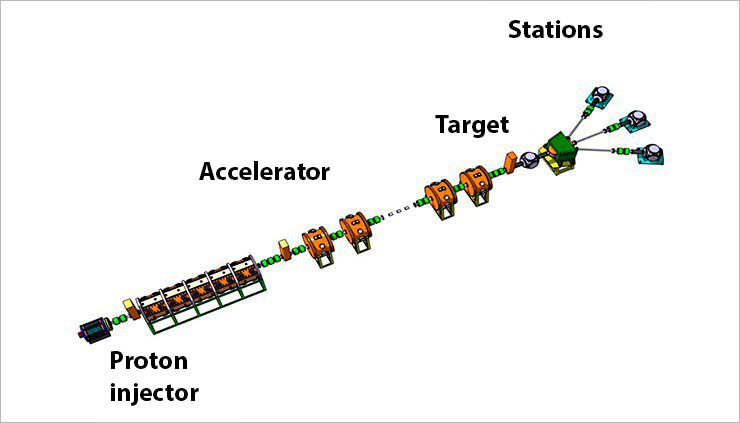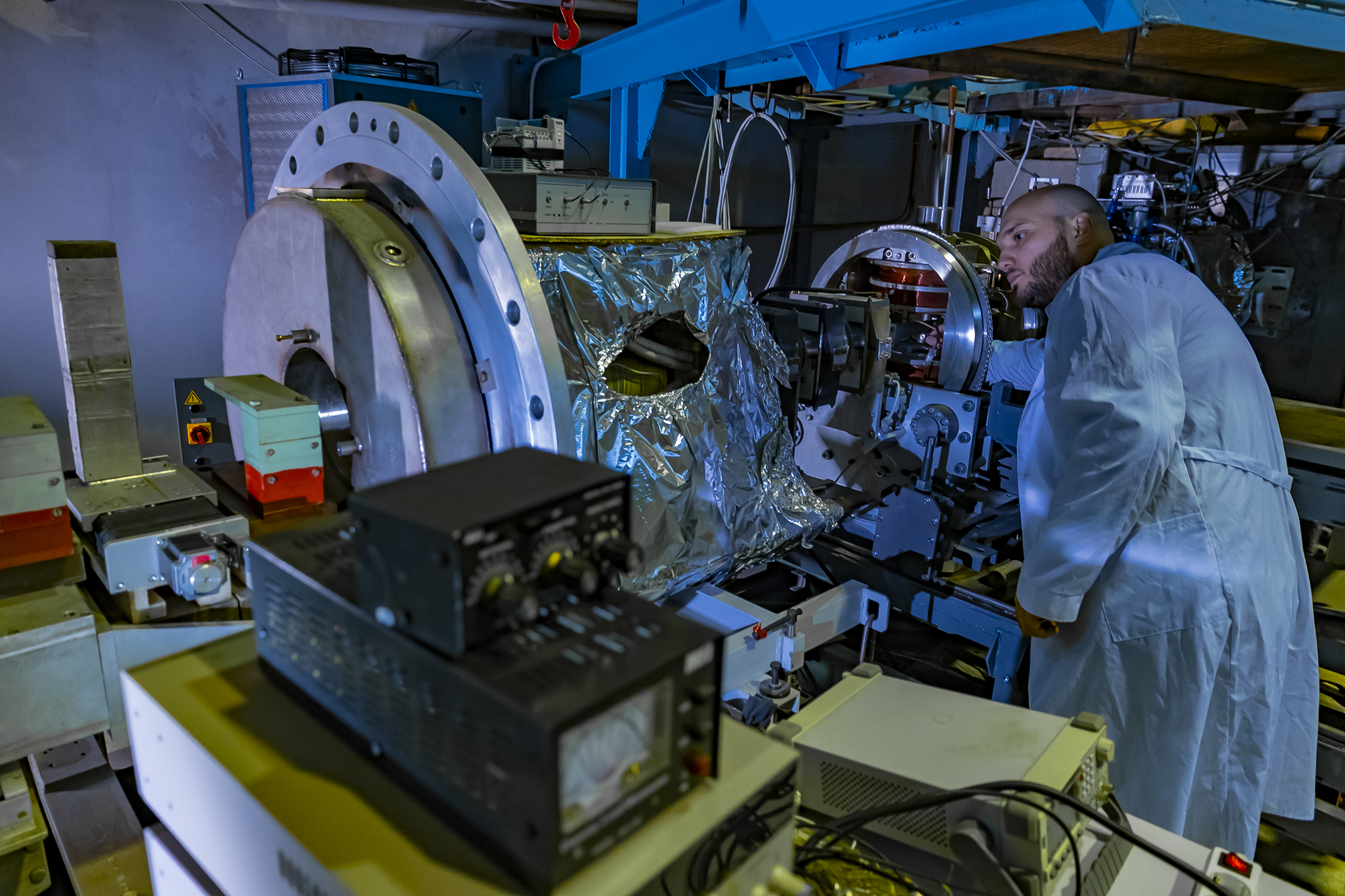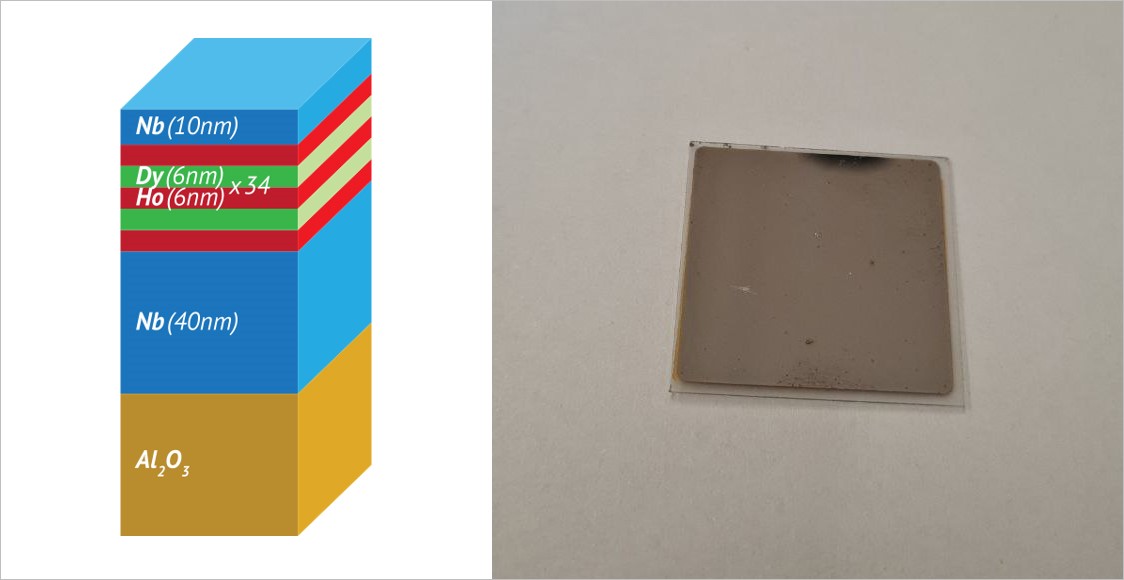JINR participates in development of neutron source for Russian universities
News, 20 May 2024
JINR takes part in the creation of DARIA (Dedicated to Academic Research and Industrial Applications) Russian Compact Neutron Source collaboratively with a number of scientific and educational centres of Russia. The facility is planned to be located at the Ural Federal University, giving students an opportunity for practical training and research. The Frank Laboratory of Neutron Physics at JINR is working on the concept of one of the six experimental facilities that will be built near DARIA. The REMUR Spectrometer at the IBR-2 Reactor at JINR served as a prototype for this facility. The new device will allow conducting research on heterostructure samples using the method of polarised neutron reflectometry developed at JINR. There is another goal of this project for FLNP at JINR, the development of neutron moderators for DARIA.
 Scheme of a compact accelerator based neutron source
Scheme of a compact accelerator based neutron source
Currently, the issue of neutronographic research is quite urgent. The method is also relevant due to the fact that it is used in the creation of innovative materials for next-generation technologies. Meanwhile, there is a shortage of user time on high-intensity neutron sources when scientists could conduct their experiments. However, numerous kinds of research can be carried out on sources of medium intensity, which DARIA is meant to be. DARIA is based on a small linear proton accelerator with an energy of 13 MeV. At the end of the path, protons will be captured by a beryllium target, and neutrons will be emitted instead. A moderator placed behind the target will set the energy spectrum of neutrons, and a system of choppers – special devices that separate one or more short bunches from a sequence of bunches or a continuous particle beam – will form neutron pulses of a given duration. The DARIA prototype will be installed at the Ural Federal University (Yekaterinburg, Russia). Some of the accelerator components have already been produced and tests are underway.
An FLNP JINR researcher Vladimir Zhaketov commented that the research programme for the developing source is already being devised. “There are discussions regarding moderators and experimental facilities: reflectometers, diffractometers, and a small angle facility for DARIA are still under development. As the source is of medium intensity, it is important to thoroughly calculate optical system of the facilities in order to gain neutron flux intensity, inferior to the IBR-2 by only an order of magnitude or less”, researcher noted.
 Vladimir Zhaketov using the REMUR Spectrometer
Vladimir Zhaketov using the REMUR Spectrometer
The DARIA design makes it possible to attach up to six scientific instruments to a neutron source. FLNP JINR specialists suggest to use time-of-flight polarised neutron reflectometer (an analogue of the REMUR Spectrometer at the IBR-2 Reactor) as one of them. Neutron reflectometry is an advanced method of research on atomic structure and magnetic properties of planar nanostructures, consequently, corresponding facilities are located on most large neutron sources. The polarised neutron reflectometry method involves the reflection of a beam of polarised neutrons from a layered structure. REMUR was designed specifically for research on the magnetism in low-dimensional films consisting of layers of rare-earth or transition metals, and proximity effects in ferromagnetic/superconductor structures.
An adjustment of analogue device will be required because the neutron flux at a compact source will not be as intense as at a reactor. Vladimir Zhaketov said that optimising the parameters of the device for research on magnetic properties and features of complex magnetic ordering in rare-earth elements includes determining the operating wavelength, as well as the neutron pulse frequency adjustment. According to the scientists, the latter may be higher than that of reflectometers at the IBR-2 Pulsed Reactor.
One of the latest studies at REMUR was the research on heterostructures with alternating layers of dysprosium and holmium helimagnets having a non-trivial magnetic ordering and helicoidal (spiral) magnetic structure. The interest in this particular combination of rare-earth metals comes from the fact that their usage is relevant when creating spintronics devices and quantum computing elements. Scientists expect to use the results of the measurements to determine the required parameters of a neutron reflectometer on the DARIA Compact Neutron Source.
Vladimir Zhaketov used a scientific paper based on REMUR and SuperADAM (ILL, France) reflectometers as an example of scientific tasks that can be solved using the new spectrometer at DARIA. A thorough research on the Dy – Ho layered structure, consisting of alternating layers of rare-earth helimagnets, was conducted. “We are actively cooperating with colleagues from the Institute of Solid State Physics of the Russian Academy of Sciences (RAS) from Chernogolovka, suggesting using such helimagnets for spin injection in Josephson junctions,” Vladimir Zhaketov highlighted. “We also have a goal to use these materials to create spin valves.”.
 Sample of the Dy – Ho layered structure
Sample of the Dy – Ho layered structure
The researcher explained that helimagnets are mostly studied by macroscopic methods. This does not allow them to be examined as thoroughly as using the neutron reflectometry method. The latter makes it possible to research into period of the helicoid with a resolution of up to one nanometre and how it changes depending on various external parameters (temperature, for example). Vladimir Zhaketov noted that additional studies are required as dysprosium and holmium begin to affect each other due to the proximity effect in periodic structures with alternating layers of these metals.
“Such nanostructures cannot always be precisely analysed due to the vast variety of properties and the lack of measurement time at world-class neutron sources. The solution to that problem may be in compact neutron sources of medium power of the DARIA type equipped with a time-of-flight neutron reflectometer,” Vladimir Zhaketov concluded.
In future, the researchers plan to examine the structure with alternating layers of superconductor and helimagnet in order to explore the interaction of superconductivity and spiral magnetism. After the resumption of operation of the IBR-2 Reactor, which has undergone lasting shutdown for maintenance, the research will be carried on.
The article entitled “On the prospects of using polarized-neutron reflectometry to study helimagnetism in rare-earth thin films and nanostructures on the DARIA Compact Neutron Source” by authors Denis Devyaterikov, Evgeny Kravtsov, Vyacheslav Proglyado (Mikheev Institute of Metal Physics of the Ural RAS Branch), Vladimir Zhaketov, Yuri Nikitenko (FLNP at JINR) and Yuri Khaydukov (Max Planck Institute for Solid State Research) was published in the Journal of Surface Investigation in 2023.